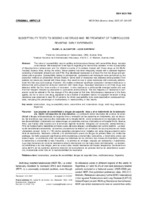Use este identificador para citar ou linkar para este item:
http://sgc.anlis.gob.ar/handle/123456789/144| Título: | Susceptibility tests to second line drugs and re-treatment of tuberculosis revisiting early experiences | Outros títulos: | Las pruebas de sensibilidad a drogas de segunda línea y el re-tratamiento de la tuberculosis: visión retrospectiva de tres estudios | Autor(es): | de Kantor, Isabel N. Barrera, Lucía |
Palavras-chave: | Tuberculosis;Tuberculosis Pulmonar;Mycobacterium tuberculosis;Tuberculosis Resistente a Múltiples Medicamentos;Argentina | Data do documento: | 2007 | Jornal: | Medicina (Buenos Aires) | Resumo: | The value of susceptibility tests in guiding antituberculous therapy with second-line drugs remains controversial. We reanalyzed three reports regarding the relationship between in vitro susceptibility of Mycobacterium tuberculosis and the clinical outcome of in-patients treated with these drugs at the Muñiz Hospital, Buenos Aires, during the sixties. These patients had been irregularly treated with a standard regimen consisting of isoniazid, streptomycin and PAS; they developed resistance to at least the first two drugs and persisted culture-positive. Susceptibility testing to ethionamide, cycloserine and kanamycin were performed by the proportion method on Löwenstein Jensen medium. Some level of resistance was detected among isolates from patients not previously treated with these drugs, that could be due to cross resistance with previously administered first line structural analogs. However, the studies evidenced significant association between resistance to ethionamide and cycloserine and prior treatment with these drugs. Increased resistance to all three drugs was detected within the first three months of treatment. In vitro resistance to ethionamide emerged earlier and was the most frequent followed by resistance to cycloserine and kanamycin. The low frequency of resistance to kanamycin could be related to the low dosage of this drug used at that time. Simultaneous resistance to the three agents, but not to two or one drug, appeared to be a marker of treatment failure. An apparent reversion of drug resistance was observed in near 6% of patients, for whom susceptibility tests were repeated on subsequent isolates, indicating this percentage of inconsistency in reproducibility of test results. |
Descrição: | Fil: de Kantor, Isabel N. Organización Mundial de la Salud (OMS). Panel de Consultores en Tuberculosis, Buenos Aires; Argentina. Fil: Barrera, Lucia. ANLIS Dr.C.G.Malbrán. Instituto Nacional de Enfermedades Infecciosas; Argentina. |
URI: | http://sgc.anlis.gob.ar/handle/123456789/144 http://www.medicinabuenosaires.com/revistas/vol67-07/3/completo/v67_3_p231_237.pdf |
ISSN: | 0025-7680 | Direitos: | info:eu-repo/semantics/openAccess Creative Commons Attribution 4.0 International License |
| Aparece nas Coleções: | snrd Publicaciones INEI |
Arquivos neste item:
| Arquivo | Descrição | Tamanho | Formato | |
|---|---|---|---|---|
| Medicina(Buenos Aires),2007,67(3),231–237.pdf | Artículo en inglés | 40.73 kB | Adobe PDF |  Ver/Aberto |
Visualização de página
83
Checado em 25/11/2025
Download(s)
27
Checado em 25/11/2025
Google ScholarTM
Checar
Este item está licenciada sob uma Licença Creative Commons


